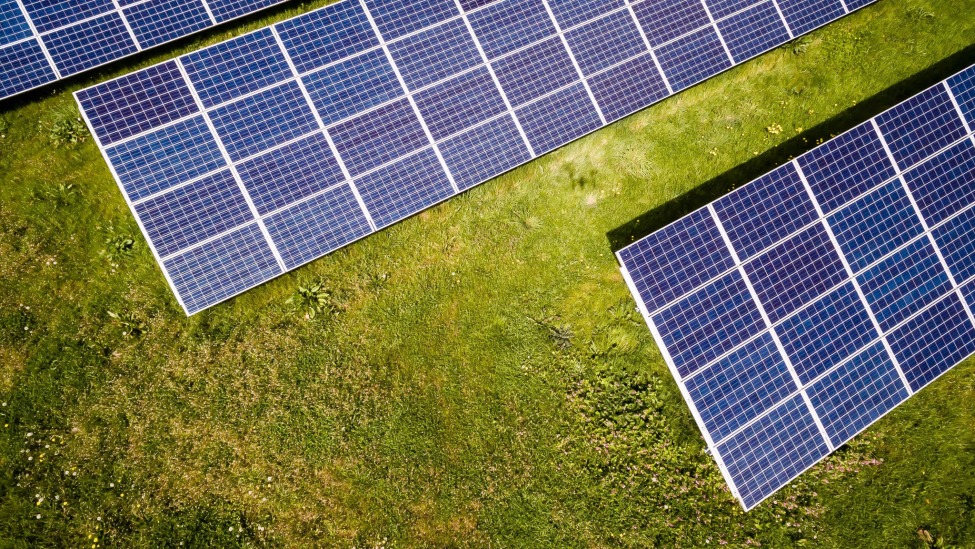
Solar power is a clean energy source that does not produce air pollutants and carbon dioxide emissions, and serves as an endless and renewable resource. This type of renewable power is an affordable and rapidly increasing source of electricity on Earth, offering one solution for replacing fossil fuels and mitigating climate change.
Solar Photovoltaic (PV)
Solar photovoltaic (PV) systems convert sunlight directly into electricity, using panels, an inverter and wiring. PV systems can be installed anywhere to power homes, businesses, or public buildings with clean solar energy – from home to business to public facilities – helping reduce fossil fuel dependency while cutting electricity bills and simultaneously increasing property values.
Solar cells are composed of semiconductor material that absorbs solar energy and converts it into electric current that powers appliances and devices. Solar energy dislodges electrons from atoms in the material, sending current through it and creating electric current that flows through an inverter before powering appliances and devices.
In order to optimize energy production from PV modules, they must be exposed directly to sunlight. Tracking systems from Family First Solar can help keep them facing towards the sun at all times. Additionally, an azimuth angle’s influence on output may vary according to its size; any deviation from its original southward orientation results in higher grid losses than larger deviations.
Homeowners who install PV systems may qualify for a one-time federal investment tax credit that covers a percentage of total system costs, and many states and municipalities provide incentives that further lower installation costs.
Solar Thermal
This thermal energy captures sunlight and converts it to useful heat energy that can then be utilized for space heating, water heating and solar cooling applications or to run traditional electricity-generating turbines in power plants known as concentrated solar power (CSP).
Solar power immediately conjures images of those shining panels adorning many rooftops today. These panels produce electricity by harnessing sunlight through electronic means to produce photovoltaic electricity – an energy source used for everything from calculators and road signs to homes and large businesses.
This newer type of technology has long been around in the form of sun-powered hot water systems and pool heaters, and alternative energy has become more readily available and affordable than you may realize. If you want to offset some or all of your electricity consumption with clean sun energy, there are various online tools that can help determine how much capacity would be necessary to do this successfully.
Most of the world’s energy capacity can be found in desert and semi-arid regions where sunny weather is more prevalent. CSP technology captures this sunshine using mirrors to reflect and concentrate it onto receivers that collect its heat before using it to generate electricity or store for later use.
Concentrating Solar Power (CSP)
CSP technologies use mirrors to reflect and concentrate sunlight onto a receiver that heats a working fluid, which in turn drives a steam turbine and generates electricity 24 hours per day, making this type of technology ideal for applications such as water desalination, enhanced oil recovery and food processing.
The United States Department of Energy’s Solar Energy Technologies Office (https://www.osti.gov/biblio/1436224) is supporting research and development projects aimed at increasing performance, decreasing cost, extending lifespan and reliability, and creating thermal energy storage systems to make CSP technologies viable renewable energy sources.
Hawaii could emerge as a leader in CSP technology thanks to its ample sunlight exposure and year-round warmth. A number of companies are developing projects using CSP, including a solar-concentrating power plant at Holaniku on Big Island.
CSP must become more cost and risk-efficient to remain viable in the market, with easier construction as it is not modular like PV panels. But its place within renewables remains undeniable as technologies such as thermal storage and cooling become more widely used.

Solar Power Towers
Thermal power plants (also referred to as CSP) are renewable energy systems that harness the sun’s rays to generate electricity. To do so, mirrors focus sunlight onto a heat receiver at the top of a tower where its heat can then be converted into steam that drives a turbine generator and ultimately creates electricity. These towers may be combined with other renewable energies for an integrated source of clean power.
Thermal power plants consist of a central tower topped by a heat receiver and an array of movable mirrors called heliostats at its base, all designed to focus the sun’s rays onto an angled receiver at concentration ratios up to 1000. Furthermore, such towers may also include thermal storage using molten salts containing nitrates for around-the-clock energy production.
One of the main benefits of solar power is that it produces no greenhouse gas emissions, air pollution or noise pollution. However, this type of energy still creates byproducts that could harm both human health and the environment – including cooling tower water which may contain contaminants or waste material. It’s important to note that all types of energy creation have some type of waste or negative effect.
Power tower construction can be both expensive and time consuming. There have been multiple projects that have been canceled or abandoned due to financial or environmental considerations; Cerra Domidor in Chile, Eurelios in Sicily and Sierra Sun Tower in Mojave Desert are just three that ran into issues.
Although power towers require large tracts of land, they’re an effective choice in remote locations where there’s ample sunlight and access to water. Cooling can either use air cooling or ground or surface water as cooling sources – though water must also be available for washing heliostats and equipment.
Towers also pose a danger to birds and other wildlife. Due to how towers focus sunlight, any bird or insect caught within its path is at risk of being burnt alive by high temperatures at the base of each tower – something particularly severe at California’s Ivanpah Solar Concentrating Power Plant where reports suggest one bird dies every two minutes due to exposure to concentrated sunlight.





